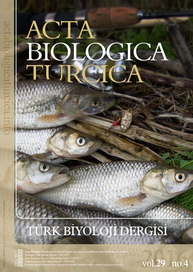Morphology of the rose chafer, Cetonia aurata (Linnaeus, 1761) (Coleoptera: Scarabaeoidea: Cetoniidae)
Abstract
In this study, the results of the surveys on the morphology and the partial biology of the developmental stages during a year of Cetonia aurata, a species of Cetoniidae, are presented. The larvae and adults of the species live in plant compost, rotten leaves, and plant roots. The study was carried out on insects growing in sheep manure in Bayat Village of Altınordu district, Ordu province. After the insects were brought to the laboratory, they were separated by stages. Insects of each stage were weighed, and body lengths and thicknesses were measured. The cephalic capsule measurements of the larvae were measured, and their photographs were taken. Adult insects feed on honey from ripe figs. From this perspective, they can be considered harmful to horticultural and agricultural crops. However, since they are a saprophyte species, they can also be considered a partially beneficial species. The species does not generally harm forestry or agriculture.
Keywords
Full Text:
PDFReferences
Ahrens D. 2006. The phylogeny of Sericini and their position within the Scarabaeidae based on morphological characters (Coleoptera: Scarabaeidae). Systematic Entomology, 31(1): 113-144.
Bale J.S. 1993. Insects in the cold. Endeavour, 17(3): 132-137.
Bezděk A. 2016. Cetoniinae, p. 367-412 - In: Löble I.E. and Löble D (eds), Catalogue of Palaearctic Coleoptera. Volume 3, Scarabaeoidea, Scirtoidea, Dascilloidea, Buprestoidea, Byrrhoidea. Revised and updated edition. Brill; Leiden, Boston. XXVIII + 983 p.
Hegedüs R., Szél G., Horváth G. 2006. Imaging polarimetry of the circularly polarizing cuticle of scarab beetles (Coleoptera: Rutelidae, Cetoniidae). Vision Research, 46(17): 2786-2797.
Lemke T., Stingl U., Egert M., Michael W., Friedrich M.W., Brune A. 2003. Physicochemical conditions and microbial activities in the highly alkaline gut of the humus-feeding larva of Pachnoda ephippiata (Coleoptera: Scarabaeidae). Applied and Environmental Microbiology, 69(11): 6650-6658.
Leng C.W. 1920. Catalogue of the Coleoptera of America, North of Mexico (John D. Sherman, Jr., Mt. Vernon, N.Y., 470 p.
Michelson A.A. 1911. LXI. On metallic colourings in birds and insects. The London Edinburg, and Dublin Philosophical Magazine and Journal of Science Series 6, 21(124): 554-567.
Ritcher P.O. 1958. Biology of Scarabaeidae. Annual Review of Entomology, 3: 311-334.
Renault D., Vernon P., Vannier G. 2005. Critical thermal maximum and body water loss in first instar larvae of three Cetoniidae species (Coleoptera). Journal of Thermal Biology, 30(8): 611-617.
Šípek P. 2005. Larvyzlatohlávk (Coeloptera: Cetoniidae) - Morfologie, taxonomie, ekologie [Larvae of the cetoniid beetles(Coleoptera: Cetoniidae): Morphology, taxonomy, biology]. Msc. Thesis, Charles University in Prague, Prague, 160 p (in Czechand English).
Šípek P., Král D. 2012. Immature stages of the rose chafers (Coleoptera: Scarabaeidae: Cetoniinae): A historical overwiew. Zootaxa 3323: 1-26.
Stavenga D.G., Wilts B.D. Leertouwer H.L., Hariyama T. 2011. Polarized iridescence of the multilayered elytra of the Japanese jewel beetle, Chrysochroa fulgidissima, Philosophical Transactions of the Royal Society B: Biological Sciences, 366(1565): 709-723.
Tauber M.J., Tauber C.A. 1976. Insect seasonality: Diapause maintenance, termination, and postdiapause development. Annual Review of Entomology, 21: 81-107.
Uliana M. 2010. Description of Pygopleurus saltinii, new species from South-Eastern Turkey (Insecta, Coleoptera, Scarabaeoidea, Glaphyridae). Bollettino del Museo di Storia Naturale di Venezia, 61: 23-29.
van Emden F.I. 1941. Larvae of British beetles II. A key to the British Lamellicornia larvae. Entomologist’s Monthly Magazine, 77: 117-127, 181-192.
Vernon P., Vannier G. 2001. Freezing susceptibility and freezing tolerance in Palaearctic Cetoniidae (Coleoptera). Canadian Journal of Zoology, 79(1): 67-74.
Refbacks
- There are currently no refbacks.

